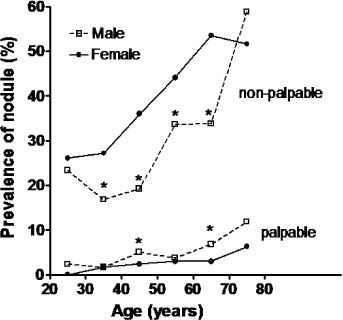Prevalence of Ultrasonographically-Detected Thyroid Nodules in Adults without Previous History of Thyroid Disease
- Affiliations
-
- 1Department of Internal Medicine, Maryknoll Hospital, Korea.
- 2Department of Internal Medicine, Asan Medical Center, University of Ulsan College of Medicine, Korea.
- 3Health Promotion Center, Asan Medical Center, University of Ulsan College of Medicine, Korea.
- KMID: 1511988
- DOI: http://doi.org/10.3803/jkes.2006.21.5.389
Abstract
-
BACKGROUND: The prevalence of palpable thyroid nodules in the general population is about 5%, and is 3~5 times higher in women than in men. However, much higher prevalence, up to 50%, was reported from autopsy data. Recently, the use of high resolution ultrasonography for routine check-up has resulted in much more detection of non-palpable thyroid nodules. We studied the prevalence of thyroid nodules in healthy adults without history of thyroid disease, and compared the prevalence in relation to palpability, age and gender.
METHODS
The prevalence of thyroid nodules was studied in adults aged from 20 to 79 years who had visited the health promotion center at Asan Medical Center, Seoul, Korea, from Jan 2002 to Dec 2003. Subjects with previous thyroid disease were excluded. 7,440 subjects (6,168 female, 1,272 men) were included in this study. Thyroid palpation was performed and followed by ultrasonography using a 12-MHz real-time scanner.
RESULTS
Thyroid nodules were detected in 3,040 of the 7,440 subjects (41%). Palpable nodules were present in 213 (3%), and non-palpable, but ultrasonographically detected thyroid nodules were present in 2,827 (38%). Thyroid nodules were present in 2,602 women (42.2%) and 370 men (29%). Among them, 159 women (2.6%) and 54 men (4.2%) had palpable thyroid nodules and 2,443 women (39.6%) and 316 men (24.8%) had non-palpable but ultrasonographically detected nodules. A significant linear trend was found between age and the prevalence of thyroid nodules.
CONCLUSIONS
The prevalence of ultrasonographically detected thyroid nodules in adults with no previous history of thyroid disease was 41%. The prevalence of palpable nodules and non-palpable, but ultrasonographically detected nodules were 3% and 38%, respectively. Thyroid nodules were detected in 42.2% of women and 29% of men, showing that thyroid nodules are very common in healthy adults, even in men.
Keyword
MeSH Terms
Figure
Cited by 3 articles
-
Management of Thyroid Nodules and Cancers Arising in the Elderly
Eunyoung Kim, June Young Choi, Kyu Eun Lee
J Korean Thyroid Assoc. 2012;5(2):99-103. doi: 10.11106/jkta.2012.5.2.99.Prevalence and Annual Incidence of Thyroid Disease in Korea from 2006 to 2015: A Nationwide Population-Based Cohort Study
Hyemi Kwon, Jin-hyung Jung, Kyung-Do Han, Yong-Gyu Park, Jung-Hwan Cho, Da Young Lee, Ji Min Han, Se Eun Park, Eun-Jung Rhee, Won-Young Lee
Endocrinol Metab. 2018;33(2):260-267. doi: 10.3803/EnM.2018.33.2.260.An Iodine Database for Common Korean Foods and the Association between Iodine Intake and Thyroid Disease in Korean Adults
Mi-Rhan Han, Dal Lae Ju, Hee-Young Paik, YoonJu Song, Young Joo Park
Int J Thyroidol. 2015;8(2):170-182. doi: 10.11106/ijt.2015.8.2.170.
Reference
-
1. Vander JB, Gaston EA, Dawber TR. The significance of nontoxic thyroid nodules. Final report of a 15-year study of the incidence of thyroid malignancy. Ann Intern Med. 1968. 69:537–540.2. Mortensen JD, Woolner LB, Bennett WA. Gross and microscopic findings in clinically normal thyroid glands. J Clin Endocrinol Metab. 1955. 15:1270–1280.3. Oertel JE, Klinck GH. Structural changes in the thyroid glands of healthy young men. Med Ann Dist Columbia. 1965. 34:75–77.4. Brander A, Viikinkoski P, Nickels J, Kivisaari L. Thyroid gland: US screening in middle-aged women with no previous thyroid disease. Radiology. 1989. 173:507–510.5. Miki H, Oshimo K, Inoue H, Kawano M, Tanaka K, Komaki K, Uyama T, Morimoto T, Monden Y. Incidence of ultrasonographically-detected thyroid nodules in healthy adults. Tokushima J Exp Med. 1993. 40:43–46.6. Hegedus L. Thyroid ultrasound. Endocrinol Metab Clin North Am. 2001. 30:339–360.7. Tomimori E, Pedrinola F, Cavaliere H, Knobel M, Medeiros-Neto G. Prevalence of incidental thyroid disease in a relatively low iodine intake area. Thyroid. 1995. 5:273–276.8. Woestyn J, Afschrift M, Schelstraete K, Vermeulen A. Demonstration of nodules in the normal thyroid by echography. Br J Radiol. 1985. 58:1179–1182.9. Brander A, Viikinkoski P, Nickels J, Kivisaari L. Thyroid gland: US screening in a random adult population. Radiology. 1991. 181:683–687.10. Ezzat S, Sarti DA, Cain DR, Braunstein GD. Thyroid incidentalomas. Prevalence by palpation and ultrasonography. Arch Intern Med. 1994. 154:1838–1840.11. Yim CH, Oh HJ, Chung HY, Han KO, Jang HC, Yoon HK, Han IK, Han BH, Lee KS, Cho BJ. Prevalence of thyroid nodules detected by ultrasonography in women attending health check-ups. J Kor Soc Endocrinol. 2002. 17:183–188.12. Kang HW, No JH, Chung JH, Min YK, Lee MS, Lee MK, Yang JH, Kim KW. Prevalence, clinical and ultrasonographic characteristics of thyroid incidentalomas. Thyroid. 2004. 14:29–33.13. Reiners C, Wegscheider K, Schicha H, Theissen P, Vaupel R, Wrbitzky R, Schumm-Draeger PM. Prevalence of thyroid disorders in the working population of Germany: ultrasonography screening in 96,278 unselected employees. Thyroid. 2004. 14:926–932.14. Kugimoto M, Maruchi N, Furihata R, Makiuchi M, Orii T. Epidemiologic studies on thyroid cancer in Nagano prefecture, Japan. Endocrinol Jpn. 1967. 14:313–319.15. Miki H, Oshimo K, Inoue H, Morimoto T, Monden Y. Sex hormone receptors in human thyroid tissues. Cancer. 1990. 66:1759–1762.
- Full Text Links
- Actions
-
Cited
- CITED
-
- Close
- Share
- Similar articles
-
- Treatment of Thyroid Nodule
- Screening of Thyroid Cancer and Management of Thyroid Incidentaloma
- Sonographic Evaluation of Thyroid Nodules
- Prevalence of Thyroid Nodules Detected by Ultrasonography in Adults for Health Check-up and Analysis of Fine Needle Aspiration Cytology
- Prevalence of Thyroid Nodules Detected by Ultrasonography in Adults for Health Check-Ups and Analysis of Fine Needle Aspiration Cytology


